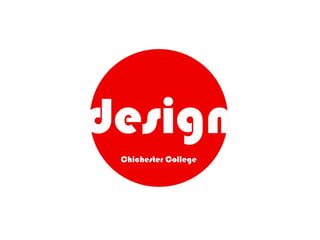
Design process initial ideas - done
- 2. Design Process - Initial Ideas
- 3. Design Process – design idea sketchbooks by students at Chichester College
- 4. Design Process – design idea sketchbooks by students at Chichester College
- 5. The design process is used by all designers in order to generate and develop solutions to solve problems or ‘challenges’ The design process is made up of 5 stages: - Briefing - Research - Initial Ideas - Design Development - Final Outcome + Presentation of Design Solution
- 8. Brainstorming can be an excellent way to begin a project. Next discuss ideas and make sketches, concept models, notes and references. At this stage it is important to be open-minded. Allow ideas to be limitless and to let them ‘flow’. Be sure to record and document every thought and idea on paper, in sketchbook or design sheet. Everything is valid at this stage.
- 10. It is important that before you can begin to design and produce a ‘solution’ there is a clear understanding of the actual problem. Design is about problem solving, and the Design Specification lists the problem in detail. The Design Specification will help you understand the problem before you start to develop your design. The more we know about the problem the easier it will be to produce a final design that ‘works’.
- 11. Design Specification should include information about the following: - Main function of the product - Any dimension or weight restrictions - An outline of the appearance and aesthetics of the design - User requirements - Details of any power sources - Any specific manufacturing processes to be used - Environmental considerations - Product life span - Any marketing, packaging or shipping considerations - Competition - Any company or branding constraints
- 12. Brainstorm
- 13. The creation of creative and innovative design ideas usually begins with a brainstorm. The brainstorm is an activity designed to generate a large number of ideas for the solution of a problem.
- 15. There are 4 ground rules for effective brainstorming: Quantity: the greater the number of ideas, the greater the chance of producing an innovative and effective solution No Criticism: put criticism of ideas at this stage ‘on hold’. Reserve criticism for the ‘development’ stage of the process. Feel free to generate unusual and creative ideas Welcome Unusual Ideas: look from new perspectives and suspend existing assumptions Combine and Improve Ideas: good ideas can be combined to form a single, better good idea. A process of connection and association can stimulate the building of ideas
- 18. Idea Visualisation - 2D (“Concept Sketch”)
- 19. Theory, philosophy, sociology and culture are becoming increasingly engaged with the act of design. The use of conceptual sketches as a design tool not only facilitates the design process of the designer but also enables his/her initial creative impulses or intentions to be communicated to others. Concept sketches are used to explore your creativity and communicate these ‘conceptual ideas’ to others. Concept is what gives art and design work it’s strength and meaning.
- 22. Concept sketches can be very experimental and ‘sketchy’ in appearance, so long as they can still clearly communicate your concept to others. Concept sketches should simply visualise and communicate your ‘concept’ or ‘creative thinking’. You do not need to express working details or final design form, etc. in concept sketches. Concept sketches should be quick. Colour may be used to support concept, but is not necessary at this point.
- 27. Idea Visualisation - 3D (“Concept Model”)
- 28. 3D Concept Visualisation follows the same principles as concept sketches but uses 3D visual language to communicate your conceptual thoughts, ideas and creative thinking.
- 32. Sketchbooks or Design Sheets should attempt to bring together both 2D and 3D visualisation of ideas together.
- 35. Initial Ideas should be documented and annotated with appropriate notes and any relevant information that helps in the communication of your conceptual thinking or ideas to others.
- 40. Initial ideas should also relate back to research and additional research may be used to communicate a greater connection between experimentation and sources of inspiration.
- 50. The initial ideas stage, as with the other stages of the design process, should also finish with a detailed and reflective evaluation. This evaluation should be used as an important design tool that will prepare you for the next stage of the design process.
